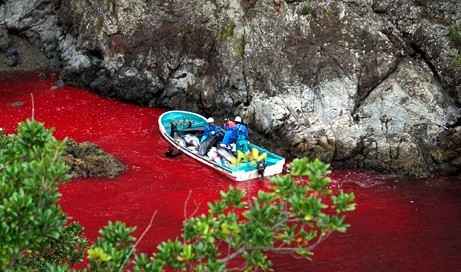 |
Sadly, neither scenario fits the bill. You can put my absence down to good old fashioned writer’s block. Yes, even non-fiction blog writers get writers block. What can I say? It happens to the best of us. *cough* and-the-not-so-best (aka me) *cough*. But enough with my self-indulgent rambling! Let’s get down to business…
So if you've frequented my blog before you might have noticed that my posts tend to revolve around dramatic fiction rather than hard-hitting documentary, but that’s something that I’m determined to change. Partly because my tastes have shifted somewhat in the film-genre department and partly because it’s good to add a dash of variety here and there, that way you won’t get bored. So I start my foray into the documentary genre with a post about the heart-breaking and eye-opening issue of dolphin slaughter that the film The Cove exposes.
I heard about this from a friend after we had a discussion about our growing obsession for documentary films and was attracted to it not only because, as a kid, dolphins were my all-time-favourite animal (literally, I was obsessed with them!) but because I was genuinely shocked to find out that these beautiful and sentient creatures were being slaughtered, and that not many people were willing to do anything about it.
The film follows the efforts of the team behind the documentary which is led by long-term activist and former dolphin trainer Ric O’Barry as they set out to expose the barbaric fisherman in the small coastal town of Taiji, Japan who are responsible for the murder of 23,000 dolphins a year. It’s a shocking statistic and one the audience is repeatedly told, perhaps to drive home the reality of such a figure. However we have little time to acclimate ourselves to this fact before we are given further evidence of the sadistic events that play out in this town and witness for ourselves the torture that these creatures are forced to endure. The crew behind this film take us to “The Cove”, which is where the slaughtering takes place, and show us the method behind the madness. O’Barry explains to the audience that the vicious and mocking fishermen lure the animals in by using their greatest strength but also their greatest weakness against them – there sensitivity to sound. As we witness the herding of these animals to their impending doom a great sense of trepidation and futility takes over the already sombre tone of the film. The activists know they can do nothing to save these creatures and so are forced to watch. Just as we, the audience, are.
 |
| Words can't really express the horror of this image nor the horrible reality that this is happening right now. |
Not only does the film show us the brutal murder of these creatures but it also offers various opinions from those concerned with the issue. We witness as various “experts” are questioned on the moral ethnicity and validity of these murders and see them shrug off these questions as if they are unimportant, which obviously strikes a great amount of anger. If government bodies and supposed conservationists are willing to shrug off dolphin murders then what else are they turning a blind eye to? Well The Cove answers that question for us too by exposing a well-kept secret amongst the general Japanese public – that not only are they consuming dolphin meat but also vast amounts of mercury, which in turn is resulting in nationwide mercury poisoning.
The facts that this film reveals are vast and almost terrifying to consider, but once you have seen the film and can understand the issues it exposes it is hard to turn a blind eye. If seeing the water turn red from the blood of so many innocent creatures being murdered is not enough to inspire our indignation, then surely the realisation that mercury poisoning is not only known but allowed on a nationwide level should? This, at the end of the day, is the films main goal. Awareness of both the cruelties and an inspiring encouragement from the filmmakers by the end credits that every viewer, young or old, can make a difference.
If my post has piqued your curiosity (I wouldn't blame you if it hasn't. I'm the first to admit that my film-blogging skills are a tad rusty!) then you can watch the film here. Hopefully you will come away as heartbroken and determinedly inspired as I did to help bring about a change, which you can do by visiting this site and signing a few petitions or perhaps even donating a penny or two to the cause (it’s as simple as that!).
To cut a long story short...
Would I recommend this film? Definitely. Though the images and actions that this documentary exposes will shock and terrify many I feel it is a necessary evil. After all, before we can help bring about change we have to first understand what needs to be changed.
A film ramblers star rating?
That's it for now folks...